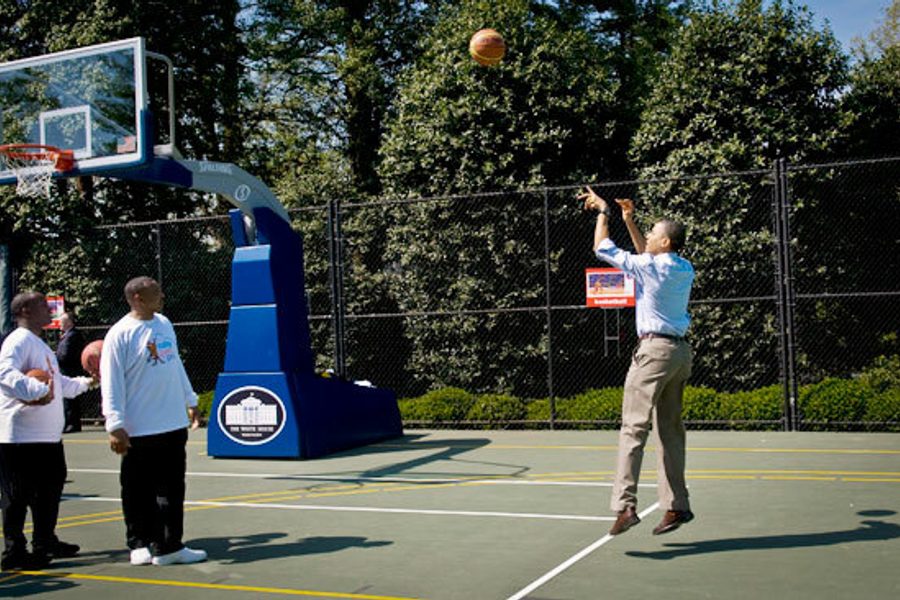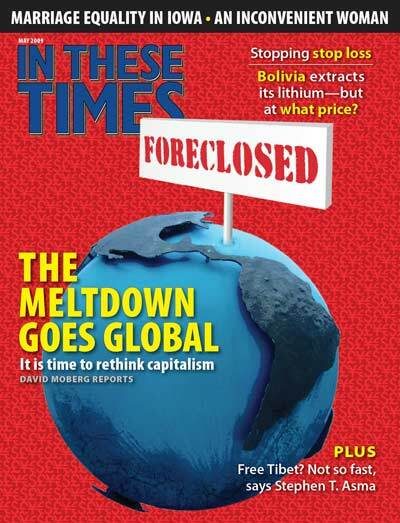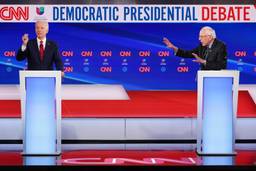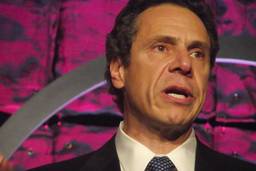‘Reform’ To Nowhere
How the crusade against earmarks threatens constitutional democracy.
David Sirota

I had never heard of an ice sled before.
I had heard of ice, had always wanted to see the Iditarod race, and had been briefly obsessed with Olympic luge competitions. But seven years ago, if you had forced me to guess what an ice sled was, I’d probably conjecture that it was an obscure vehicle from the first snowy vistas of Hoth in Empire Strikes Back. And if you asked me what one was doing in the federal budget, I, like most of know-nothing Washington, might have told you it was a “wasteful” local spending project inserted by a member of Congress – one of those “awful” earmarks.
That is, until I discovered that it was an earmark from the guy who employed me, Rep. David Obey (D-Wis.).
As press secretary for Obey’s Appropriations Committee in 2002, I learned more in a few months about emergency ice sleds and their life-saving import in the Arctic tier of America (typically defined as any place north of Chicago) than most winter-loathing sons of the relatively temperate Mid-Atlantic states ever do.
I also learned why the attempt to ban Congress’s right to earmark-spending bills is anti-democratic and destructive.
The argot of meritocratic technocracy
In 2002, President Bush decided to try to make the ice sled – specifically, the federally funded one in Ashland, Wis. – the poster child for government waste.
“In a first for federal budgets, a color photo of an ice sled is featured in Bush’s 2003 budget plan,” read a lengthy USA Today story that noted the picture was designed as Bush’s “stern rebuke of all the local projects lawmakers insert into the budget every year.”
The president wanted a tangible target to ridicule in order to justify his broader allegations that, a) government spending initiatives – especially Democratic-backed ones – are inherently wasteful, and that b) all congressional earmarks must be banned.
The first claim was – and still is – a tried-and-true tactic in Republicans’ broader attack on social spending. Understanding the cultural and geographic ignorance of the national press corps to regions outside the Beltway, the GOP selects local projects that sound absurd to the untrained ear and thus can be easily ridiculed by pithy – and misleading – headlines.
In the ice sled’s case, the Bush administration figured it could caricature Obey’s earmark as a hilarious boondoggle that would make the Pentagon’s legendary $600 toilets look positively practical.
This line of attack is fairly simple to debunk – that is, if an earmark is, in fact, substantive, and if the media are interested in anything more than sensationalism. (Both genuine “ifs.”)
When Bush unleashed his attack on Obey’s ice sled, for example, we called on local police officers who recounted deaths and near-deaths on Lake Superior and Ashland County’s frozen lakes that the ice sled would now prevent. After first laughing at what seemed to be an $80,000 Flexible Flyer, reporters who bothered to investigate learned that it was a much-needed tool for Northern Wisconsin’s first responders. USA Today and other national news outlets subsequently filled their stories with this compelling justification for the project.
The other facet of the Bush administration’s argument, however, has proven more persistent.
While most individual earmarks pass muster upon close scrutiny, presidents portray the earmarking process as fundamentally corrupt. Of course, if the last decade of no-bid contracts to campaign contributors, bungled bailouts and hegemonic politicization of the federal bureaucracy teaches anything, it is that executive branch spending decisions are not inherently less political or less corrupt than legislative branch decisions.
And yet, anti-earmarking rhetoric from White Houses of both parties is effective. A public already suspicious of government efficiency loves the argot of blue-ribbon meritocracy and empirical technocracy, even if it is absurd – even if it obscures presidents’ ulterior motive: to accrue as much power as possible.
Undermining the power of the purse
Article I, Section 9 of the U.S. Constitution says, “No money shall be drawn from the Treasury, but in consequence of appropriations made by law.”
This sentence cements what is now considered one of the pillars of modern constitutional democracy: bestowing the power of the purse in a government’s legislature. The principle is based on the belief that spending (and taxing) is the ultimate exercise of state power, and therefore that authority should be vested in the legislature – the branch of government most democratically accountable and locally connected to the public.
But that very principle is an affront to White House power. And in the age of the imperial presidency, we have witnessed an assault on Congress’s power of the purse. As the Iraq War and the Wall Street bailouts have shown, executives can now easily coerce the legislative branch into handing over trillion-dollar blank checks without fear of oversight. In that sense, our government is already far more authoritarian and less democratic than it was a half-century ago.
One of the few remaining constitutional holdouts is the earmarking process, which lets individual lawmakers direct the executive branch to spend taxpayer money in explicit ways. Though the sensationalistic media try to imply that local projects make up most of the federal budget, the truth is that earmarks make up less than 2 percent of all federal expenditures.
Nonetheless, that’s 2 percent less unilateral power for a president. And so, out of Bush’s 2002 anti-earmark jihad comes a new era in which talk of banning all earmarks dominates the presidential discourse in both parties.
During the 2008 presidential campaign, for instance, Republican nominee Sen. John McCain (Ariz.) staked his campaign on a belief that Americans would see the elimination of congressional earmarks as the single most powerful solution to the global economic meltdown.
Now, emerging from the ashes of that campaign is a new generation of conservative blogs, such as NextRight.com, publishing screeds about “Why We Need to Ban Earmarks.” They deride these projects as “mini-bailouts” for local communities and insist that an anti-earmark stand “is a political winner for Republicans.” (Republicans, it must be noted, not only oversaw a four-fold increase in total earmarks, but also engineered Jack Abramoff’s earmark corruption scandals.)
Likewise, one of President Obama’s first declarations as he entered office was a promise “to ban all earmarks” in economic stimulus legislation. And upon signing the last budget bill leftover from Bush’s term, he delivered a speech deriding earmarks and promising “an end to the old way of doing business.”
At a time of exploding budget deficits and fresh memories of earmark-related corruption scandals, this rhetoric can sound convincing. Indeed, the prospect of an “end to the old way of doing business” sounds positively refreshing – until you consider that earmarks represent the kind of “old way of doing business” that is enshrined in the Constitution and protects our democracy.
The right kind of reform
The current earmarking process isn’t perfect. Abramoff’s success in trading campaign contributions for shadowy earmarks proves that there is ample room for reform that can preserve the legislature’s power of the purse and stop abuse – the kind of reform, in fact, that is already underway.
In January, Roll Call newspaper reported that House Appropriations Committee Chairman Obey and Senate Appropriations Chairman Daniel Inouye (D-Hawaii) have “jointly vowed to slice the level of earmarks” while requiring lawmakers “to post the requests on their websites explaining the purpose of the earmark and why it is a valuable use of taxpayer funds.”
If critics really believe “Bridge to Nowhere” waste is the big problem in earmarking, and if earmark waste is most often created by lawmakers who anonymously insert projects into spending bills, then stricter transparency is one way to substantively reform the process while preserving constitutional principles.
Prior to these reforms, a legislator could put an indefensibly wasteful earmark into a bill without fear of being ridiculed in the press or by watchdog groups. Now (assuming the reforms have teeth), disclosure rules would open that legislator up to public ridicule, hence manufacturing a powerful disincentive for abusive earmarks.
Similarly, for earmark critics who are sincerely concerned about projects being used as pay-to-play financial rewards to unworthy corporate campaign donors, there is Obama’s pragmatic proposal to “bar lawmakers from directing earmarks to for-profit companies without competitive bidding,” as The Hill newspaper reported in March. If a given company is un-deserving of federal money and cannot beat out a competitor, it won’t get the earmark.
Even more commendable reform proposals exist that would improve the earmarking process and protect Congress’s constitutional prerogatives – from making spending bills Google-searchable to publicly financing congressional elections (so as to remove the possibility of campaign dollars corrupting federal spending decisions).
And yet, before any of these are enacted and tested, the drumbeat for a total earmark ban continues.
The consequences of a ban
Democratic ideals are borne out of practicality, not theory. Trample those ideals, and there are bound to be unpopular real-world consequences.
The fact is, either Congress or the White House is going to make specific decisions about how to spend federal dollars in states and congressional districts. Therefore, those ideologues who want to undermine Congress’s power of the purse and ban earmarks (rather than merely reforming the process) are saying they believe those decisions are made more astutely by executive branch appointees in Washington, D.C., than by locally elected congressional representatives who spend much of their time in their districts interacting with constituents.
Rep. Peter DeFazio (D-Ore.) made this point during a recent CNN interview. Noting that the same conservatives who decry earmarks also decry centralization of power in Washington, he asked, “Is all the wisdom in this country in the bureaucrats in Washington, D.C., or the political appointees in Washington, D.C.? … No. I represent my district; I know where the needs are. I put money toward those needs, and I put my name next to them, and I send out press releases, and I stand for election every two years [so] I don’t share [an] aversion to earmarks.”
In the same vein, a Congress member’s access to the federal purse via earmarking often provides communities their only way to influence a lobbyist-insulated government. In the case of the ice sled, for instance, Ashland law enforcement officials never received a response to the grant-request letters they sent to federal agencies. Their only avenue to get the modest funds they needed was through Obey, their local member of Congress. Had he been barred from trying to earmark federal money, those law enforcement officials – like the uncountable constituents in districts all over the United States – would have continued to be ignored by the federal bureaucracy.
This is why members of Congress spend much of their promotional resources bragging about the earmarks they’ve secured – because local constituents want and need local spending projects, and they like to know they have access to federal spending decisions.
In that sense, earmarks are a direct reflection of representative and responsive government: the public likes them, and, so, Congress creates and passes them into law.
Isn’t that what democracy is supposed to be about?
Tasty brats and cheese
Almost seven years after I learned everything I ever wanted to learn about emergency ice sleds, I happened to be watching midday MSNBC when network correspondent Norah O’Donnell began interviewing Wisconsin Gov. Jim Doyle about today’s renewed push to ban earmarks. After O’Donnell berated a project to mitigate the environmental impact of corporate hog farms on local communities as “taxpayer money going to pig odor research,” she demanded to know why Doyle didn’t want all earmarks eliminated.
Doyle desperately tried to explain how significant factory farms are in the Midwestern economy, and thus how important the mitigation earmark was to small town America. But O’Donnell only responded with derision and disbelief.
“One man’s trash is another man’s treasure,” she said, before feigning some forced Americana in her sign off, adding, “Best to you in Wisconsin, one of my favorite states – I love the brats, I love the cheese.”
For all the substantive arguments against banning earmarks – for all of the concern about executive power grabs, the trampling of democracy, and the evisceration of the legislative branch – the exchange was yet another reminder that this earmark debate still rages in Washington because it is manufactured by a culturally and geographically isolated press corps that worships presidential power, views constitutional democracy as a joke, and sees the public as rubes, good for our tasty brats and cheese, but not for our input into critical spending decisions.
That over simplistic elitism – more than even power-hungry presidents or budget-cutting conservatives – is what genuinely threatens Congress’s power of the purse, public access to the federal government and ultimately, American democracy.
David Sirota is an award-winning investigative journalist and an In These Times senior editor. He served as speechwriter for Bernie Sanders’ 2020 campaign. Follow him on Twitter @davidsirota.









